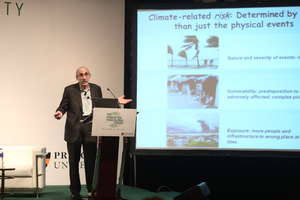
Are cities collections of problems that need to be solved or sites of innovation that offer opportunities? Are they best managed by top-down planning and policies or bottom-up entrepreneurialism? These themes and many more were the focus of the inaugural Princeton-Fung Global Forum, “The Future of the City,” held January 30–February 1 in Shanghai. The papers presented during the event were as diverse as its 48 speakers, a collection of international academics—20 from Princeton University—in architecture, engineering, ethics, history, meteorology, and other fields, as well as a handful of nonacademics. The multitude of voices did not offer a cohesive picture of the city, but attempted to present its variety through cross-disciplinary lenses.
 |
| Photo courtesy Princeton University Michael Oppenheimer, professor of geosciences and international affairs at Princeton, discusses the impact of climate change on coastal cities. |
William Fung, group chairman of the Hong Kong–based Li & Fung trading company and funder of the forum, opened the meeting. Then followed three days of 13 sessions with timely urban subjects, from “Home” to “Planning and Equity” to “Coastal Cities and Climate Change.” Many of the presentations were city-specific case studies. Janet Y. Chen, an assistant professor of history at Princeton, discussed hut dwellers in 20th-century Shanghai. Ariella Masboungi, from the French Ministry for Sustainability, shared a master plan for Grand Paris. Architects Rupali Gupte and Juan Du looked at microenvironments within megacities: the complex occupancy systems of Mumbai and the urban villages of Shenzhen, respectively. Other speakers reviewed broader urban patterns. Jiaotong University arts and humanities professor Daniel A. Bell discussed the change from nationalism to city affiliation, while Columbia University professor of sociology Saskia Sassen reviewed financing and the global city.
“Presence of the city” might have been a better name for the forum than “future of the city,” as the work of economists, anthropologists, and the like is necessarily documentary instead of visionary. An exception to this was the design work in the project showcase “The Resilient City,” presented in posters, displays, and informal discussions. This included three planning and architectural projects in China: structural engineer Guy Nordenson and chemical engineer Howard Stone showed a flood-management system for the Yangtze River Delta based on Dutch polders; Syracuse University’s Jonathan Solomon and Hong Kong University’s Dorothy Tang shared responses to climate change in the Pearl River Delta; and Princeton’s Mario Gandelsonas exhibited a linear plan for the expansion of Suzhou.
“The Resilient City” display moved to Shanghai’s Tongji University after the conclusion of the forum. The distribution of the rest of the conference material is yet to be decided, but the remarkable amount of research discussed at the “The Future of the City” should make its way beyond the academy and the forum’s 138 registrants to the governments, planners, architects, and city dwellers that can benefit from it.

Post a comment to this article
Report Abusive Comment